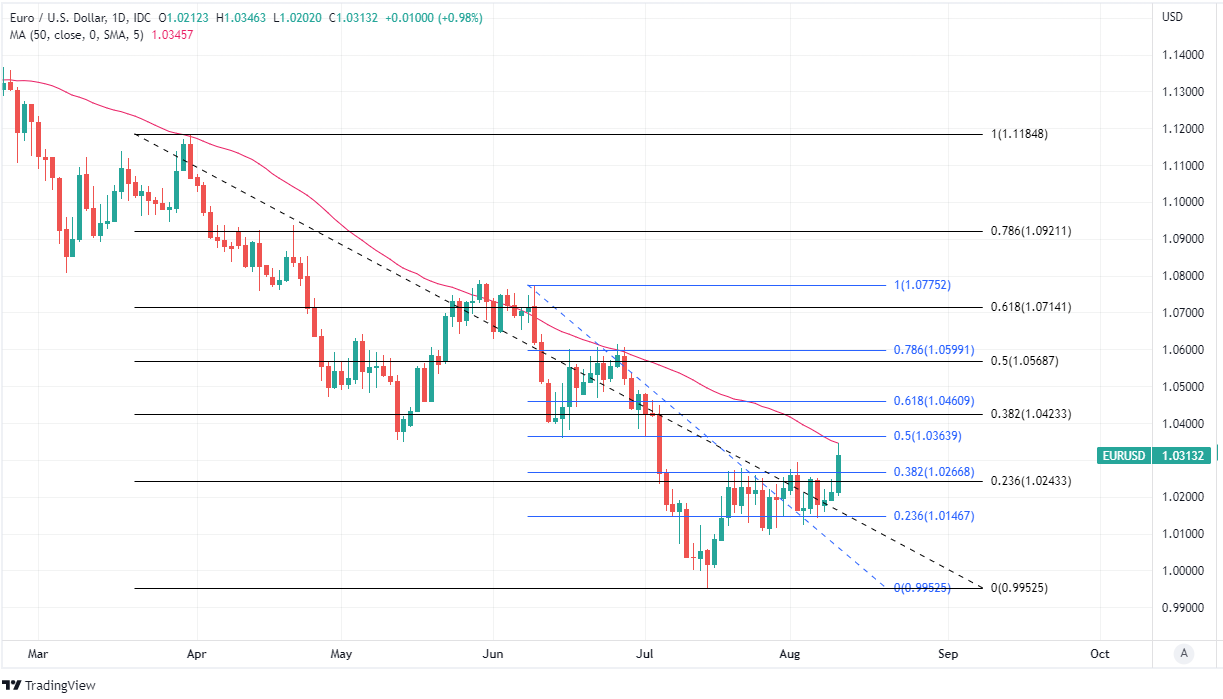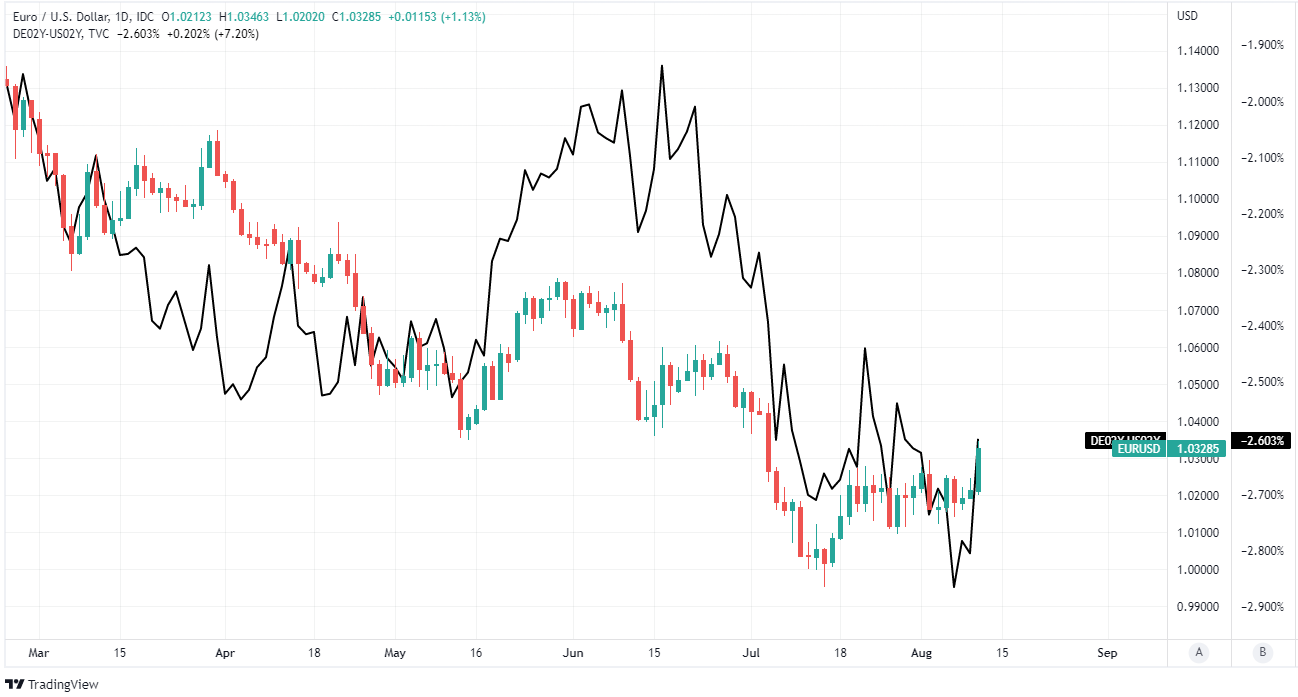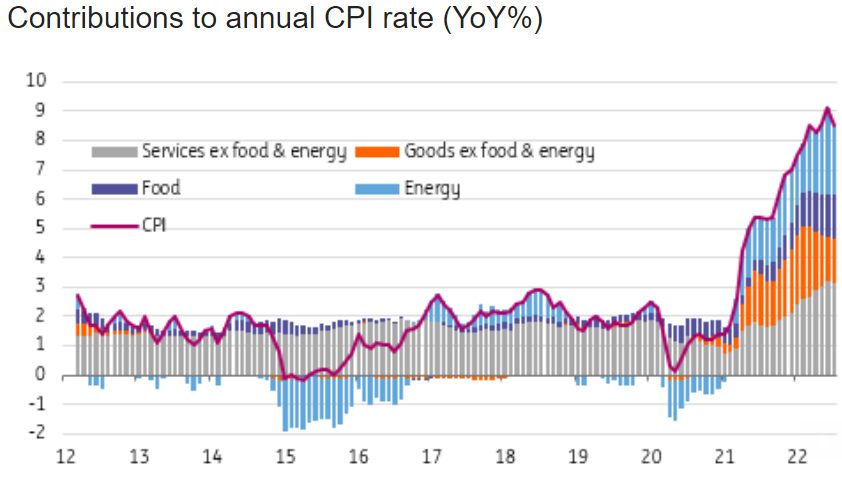EUR/USD Rate in Tentative Breakout on Charts
- Written by: James Skinner
"We’re close to the peak in y/y inflation for the US. However, the real problem is still getting back to target on the inflation side of the mandate for the Fed," - CIBC Capital Markets.

Commerzbank HQ looms over the Frankfurt skyline. Image © Andre Douque, reproduced under CC licensing conditions
The Euro to Dollar exchange rate leapfrogged a double-barreled layer of technical resistance on the charts after both official measures of U.S. inflation came in lower than was anticipated by the market for July, leading American bond yields and the Dollar to retreat further from recent highs.
Europe's single currency overcame two layers of resistance when rallying to its 50-day moving-average at 1.0345 on Wednesday after falling gasoline prices pulled the overall U.S. inflation rate lower from 9.1% to 8.5% for last month.
Economists had expected that measure to come in at 8.7% but in the event falling prices of gasoline and natural gas offset increases in the cost of electricity, food and housing to weigh heavier on the barometer.
"We’re close to the peak in y/y inflation for the US. However, the real problem is still getting back to target on the inflation side of the mandate for the Fed," says Bipan Rai, North American head of FX strategy at CIBC Capital Markets.
"The impulse in goods-driven inflation may be declining, but not so much on the services side (which tends to be far more sticky)," Rai cautioned on Wednesday.
 Above: Euro to Dollar rate shown at daily intervals with Fibonacci retracements of April and June declines indicating possible areas of short-term technical resistance for the Euro. Click image for closer inspection.
Above: Euro to Dollar rate shown at daily intervals with Fibonacci retracements of April and June declines indicating possible areas of short-term technical resistance for the Euro. Click image for closer inspection.
Meanwhile, the more important core inflation rate was unchanged at 5.9% in defiance of expectations for an increase to 6.1% after falls in prices of airline fares, used cars, trucks, communications, and clothing categories offset increases that were seen elsewhere.
"Powell went to lengths to highlight its importance at the last FOMC," Rai said of the Federal Reserve (Fed) stance on the core inflation rate.
Rai and CIBC colleagues also flagged the 50-day moving average pictured in the chart above as a likely area of short-term resistance for the Euro.
Analysts and economists generally cautioned on Wednesday that the data is unlikely to deter the Fed from the projections set out in June, which envisaged an interest rate of anywhere between 3% and 3.5% by year-end.
Source: ING Group.
"Today’s report should provide support to the notion that the US has now passed the peak for headline inflation with lower gasoline prices, down a dollar a gallon nationally on their June 13 peak, set to have a more substantial impact in the August inflation print. We are forecasting the YoY rate dropping to 8.3%," says James Knightley, chief international economist at ING.
"However, core inflation remains on an upward trajectory due to rising housing rental costs and service sector inflation pressures. Wages are the biggest cost input for the service sector," Knightley also cautioned on Wednesday.
The inflation figures followed closely behind other data from the Bureau of Labor Statistics suggesting on Tuesday that per-person employment costs rose by an annualised 10.8% in the second quarter following a 12.6% increase previously.
That data partly reflects elevated pay growth rates that were also depicted rising at an accelerated pace in the non-farm payrolls report released last week, which matters because the Fed and other central banks view wage growth as an important influence on inflation.
 Above: Euro to Dollar rate shown at daily intervals with spread or gap between 02-year German and U.S. government bond yields. Click image for closer inspection.
Above: Euro to Dollar rate shown at daily intervals with spread or gap between 02-year German and U.S. government bond yields. Click image for closer inspection.





